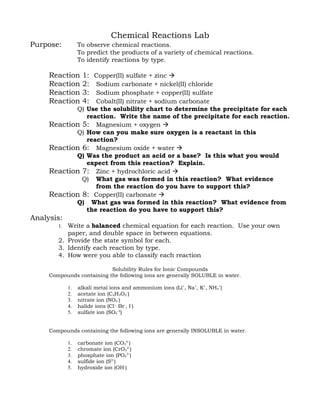
Chemical reactions lab 10 make up
- 1. Chemical Reactions Lab Purpose: To observe chemical reactions. To predict the products of a variety of chemical reactions. To identify reactions by type. Reaction 1: Copper(II) sulfate + zinc Reaction 2: Sodium carbonate + nickel(II) chloride Reaction 3: Sodium phosphate + copper(II) sulfate Reaction 4: Cobalt(II) nitrate + sodium carbonate Q) Use the solubility chart to determine the precipitate for each reaction. Write the name of the precipitate for each reaction. Reaction 5: Magnesium + oxygen Q) How can you make sure oxygen is a reactant in this reaction? Reaction 6: Magnesium oxide + water Q) Was the product an acid or a base? Is this what you would expect from this reaction? Explain. Reaction 7: Zinc + hydrochloric acid Q) What gas was formed in this reaction? What evidence from the reaction do you have to support this? Reaction 8: Copper(II) carbonate Q) What gas was formed in this reaction? What evidence from the reaction do you have to support this? Analysis: 1. Write a balanced chemical equation for each reaction. Use your own paper, and double space in between equations. 2. Provide the state symbol for each. 3. Identify each reaction by type. 4. How were you able to classify each reaction Solubility Rules for Ionic Compounds Compounds containing the following ions are generally SOLUBLE in water. 1. alkali metal ions and ammonium ions (Li+, Na+, K+, NH4+) 2. acetate ion (C2H3O2-) 3. nitrate ion (NO3-) 4. halide ions (Cl-, Br-, I-) 5. sulfate ion (SO4-2) Compounds containing the following ions are generally INSOLUBLE in water. 1. carbonate ion (CO32-) 2. chromate ion (CrO42-) 3. phosphate ion (PO43-) 4. sulfide ion (S2-) 5. hydroxide ion (OH-)